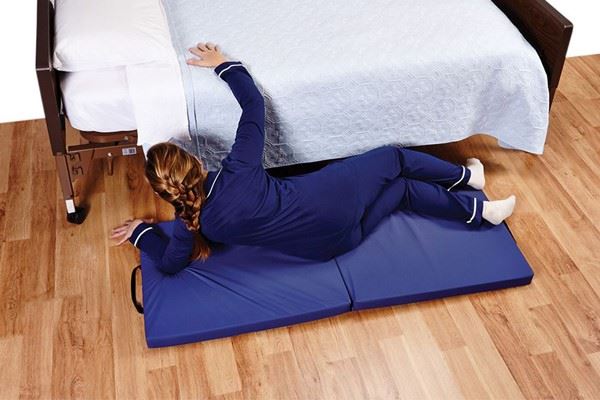-
Home
-
Enhancing Patient Safety with Fall Mats in Hospitals
Enhancing Patient Safety with Fall Mats in Hospitals
May 29, 2024
 Fall prevention is a crucial aspect of patient safety in hospitals. One effective way to reduce the risk of falls and injuries is by using fall mats. These specially designed mats provide cushioning and support to patients who are at risk of falling, helping to prevent serious injuries. In this article, we will explore the importance of fall mats in hospitals, the different types of mats available, and how they work to enhance patient safety as part of a comprehensive fall prevention program.
Fall prevention is a crucial aspect of patient safety in hospitals. One effective way to reduce the risk of falls and injuries is by using fall mats. These specially designed mats provide cushioning and support to patients who are at risk of falling, helping to prevent serious injuries. In this article, we will explore the importance of fall mats in hospitals, the different types of mats available, and how they work to enhance patient safety as part of a comprehensive fall prevention program.
Do Fall Mats Prevent Injury?
Fall mats are designed to help prevent injuries by providing a soft landing surface for patients who may accidentally fall out of bed or lose their balance while standing or walking. The cushioning effect of the mat helps to absorb impact and reduce the force of the fall, minimizing the risk of serious injuries such as fractures or head trauma.
Types of Fall Mats
Fall mats come in various types, each designed to meet specific needs and environments. Some of the most common types used in hospitals are standard, low-profile, alarmed, and waterproof fall mats.
- Standard Fall Mats: Made from high-density foam, these mats provide a cushioned surface to absorb the impact of a fall. They are commonly used in general hospital wards and nursing homes, offering a reliable solution for protecting patients from injury.
- Low-Profile Fall Mats: Thinner than standard mats, low-profile fall mats are designed to minimize tripping hazards while still offering adequate protection. They are ideal for patients who may be unstable or have difficulty navigating higher mats.
- Alarmed Fall Mats: These mats are equipped with pressure-sensitive alarms that alert healthcare staff when a patient steps on the mat. This feature is particularly useful for immediate response to potential falls, especially in high-risk patients who require constant monitoring.
- Waterproof Fall Mats: Constructed with materials that repel liquids, waterproof fall mats are easy to clean and maintain. They are suitable for areas where spills or incontinence are common concerns, ensuring hygiene and safety in various hospital environments.
What Are the Key Elements of Fall Prevention?
Fall prevention in hospitals requires a multi-faceted approach. By incorporating fall mats into their fall prevention program, hospitals can improve patient safety and reduce the incidence of falls and injuries. Key elements of fall prevention include risk assessment, environmental modifications, patient education, staff training, assistive devices, and medication management.
Risk Assessment
Identifying patients at high risk for falls through comprehensive assessments is crucial. This involves collecting detailed information on each patient's medical history, current condition, and previous fall incidents. Tools such as the Morse Fall Scale help in evaluating specific risk factors. These tools provide a structured approach to determine the likelihood of a fall, enabling healthcare providers to implement targeted prevention strategies.
Environmental Modifications
Ensuring patient rooms and common areas are free of obstacles and hazards is essential for preventing falls. This includes regular checks to remove clutter, secure loose cables, and ensure that furniture is arranged safely. Adequate lighting, non-slip flooring, and handrails are critical components of a safe environment.
Patient Education
Educating patients about the risks of falls and ways to move safely is a key element of fall prevention. Patients should be informed about the potential dangers of falling and taught techniques to avoid falls, such as rising slowly from a seated position and using support when walking. Encouraging the use of assistive devices and proper footwear can also help patients maintain balance and stability, reducing the risk of falls.
Staff Training
Training healthcare staff to recognize fall risks and implement prevention strategies is vital. Staff should be able to identify high-risk patients and take appropriate measures to prevent falls. Regularly updating staff on best practices for fall prevention ensures that they are knowledgeable about the latest strategies and tools available. Continuous education helps maintain a high standard of care and safety.
Use of Assistive Devices
Providing walkers, canes, and other mobility aids to patients who need them is an effective way to enhance safety. These devices help patients maintain their balance and move more confidently. Ensuring these devices are properly fitted and used correctly is important to maximize their benefits. Healthcare providers should assess the fit and function of assistive devices regularly to ensure they continue to meet the patient's needs.
Medication Management
Reviewing and managing medications that may contribute to fall risk, such as sedatives and blood pressure medications, is a critical component of fall prevention. Certain medications can cause dizziness, drowsiness, or balance issues, increasing the risk of falls. Regular medication reviews allow healthcare providers to adjust dosages or switch medications as needed to minimize these side effects and reduce fall risk.
Fall prevention is an essential component of patient safety in hospitals, and utilizing fall mats can greatly contribute to reducing the incidence of injuries from falls. By understanding the different types of fall mats available, how they work, and their importance in enhancing patient safety, healthcare providers can effectively implement these tools into their fall prevention programs.